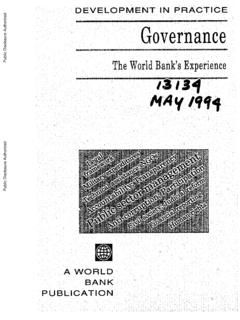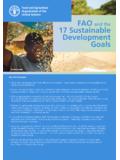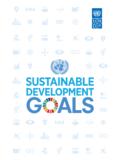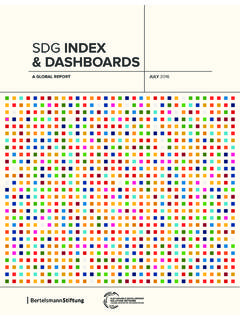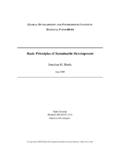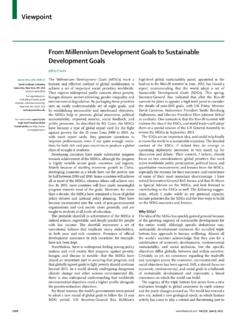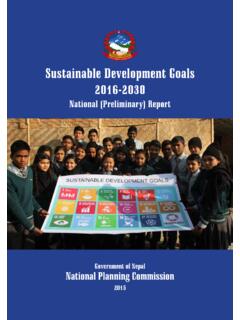Transcription of Sustainable Development Goals Diagnostics
1 Policy Research Working Paper8481 Sustainable Development Goals DiagnosticsAn Application of Network Theory and Complexity Measures to Set Country PrioritiesM. H. El-MaghrabiS. GableI. Osorio RodarteJ. VerbeekOffice of the Senior Vice PresidentUN Relations and PartnershipsJune 2018 WPS8481 Public Disclosure AuthorizedPublic Disclosure AuthorizedPublic Disclosure AuthorizedPublic Disclosure AuthorizedProduced by the Research Support TeamAbstractThe Policy Research Working Paper Series disseminates the findings of work in progress to encourage the exchange of ideas about Development issues. An objective of the series is to get the findings out quickly, even if the presentations are less than fully polished. The papers carry the names of the authors and should be cited accordingly. The findings, interpretations, and conclusions expressed in this paper are entirely those of the authors. They do not necessarily represent the views of the International Bank for Reconstruction and Development /World Bank and its affiliated organizations, or those of the Executive Directors of the World Bank or the governments they Research Working Paper 841 This paper is a product of the Office of the Senior Vice President, 2030 Agenda, UN Relations and Partnerships.
2 It is part of a larger effort by the World Bank to provide open access to its research and make a contribution to Development policy discussions around the world. Policy Research Working Papers are also posted on the Web at The authors may be contacted at The United Nations 2030 Agenda and the Sustainable Devel-opment Goals are comprehensive and holistic in nature, as they includes 17 Goals and 169 targets covering economic, social, and environmental dimensions of Development . In this context, policy makers face the challenge of translating the global agenda into feasible yet ambitious Development plans and policies. This paper presents a methodology that can assist policy makers in prioritizing the targets of the Sustainable Development Goals within their develop - ment plans, given elements of path dependency among the Goals . The method used is based on the notion that existing patterns of Development outcomes can reveal infor-mation about the commonalities in countries unobservable Sustainable Development Goal delivery mechanisms.
3 The ease with which capacities can be used between Sustainable Development Goals depends on their degree of commonal-ity, conceptualized in the proximity between them. Related to this, the paper introduces Sustainable Development Goal centrality as a measure of connectedness. In addition, it defines a country s Sustainable Development Goals den-sity to indicate how close an unsuccesful Sustainable Development Goals is to those Sustainable Development Goals in which a country is performing well. The paper concludes that countries should prioritize the Sustainable Development Goals that are within reach (high density) and/or offer higher scope for success through redeploy- ment of existing capacities (high centrality). It applies the method to show how this can help countries prioritize implementation of the Sustainable Development Goals . Sustainable Development Goals Diagnostics : An Application of Network Theory and Complexity Measures to Set Country Priorities M.
4 H. El Maghrabi,* S. Gable, I. Osorio Rodarte,* and J. Verbeek*1 Keywords: Sustainable Development Goals , network theory and implementation, economic complexity, proximity, centrality, density, benchmarking of the SDGs JEL Classification: C50, D85, H11, I00, O19, O21, O50 * All with the World Bank Group. + Chief Economist of Swedish International Development Cooperation Agency. 1 The paper was prepared under the general guidance of Mahmoud Mohieldin and benefitted from Hans Lofgren s constructive engagement. This note is part of a series of analytical initiatives by the Office of the World Bank s Senior Vice President of the 2030 Agenda, UN Relations and Partnerships. In addition, the Office of the Senior Vice President produced the Trajectories for Sustainable Development Goals (Gable et al., 2015), which included ten country case studies encompassing the earlier SDG Country Development Diagnostic framework, as well as the report Financing for Development Post 2015 (World Bank, 2013) and Sustainable Development Goals Diagnostics : The Case of Egypt (Amin Salem et al, 2018).
5 The findings, interpretations, and conclusions expressed in this paper are entirely those of the authors. They do not necessarily represent the views of the International Bank for Reconstruction and Development /World Bank and its affiliated organizations, or those of the Executive Directors of the World Bank or the governments they represent. 2. Existing tools for SDG benchmarking 21. Introduction The UN 2030 Agenda and the Sustainable Development Goals (SDGs) are comprehensive and holistic in nature, as they include 17 Goals and 169 targets covering economic, social, and environmental dimensions of Development . The highly ambitious agenda stresses that all individuals shall collectively benefit from the fruits of Development and that no one shall be left behind. In this context, policy makers face the challenge of translating the global agenda into feasible yet sambitious Development plans and policies.
6 Hence, there is a need to develop methodologies that can assist during different steps in this process: from data measurement and benchmarking, to prioritization of targets and monitoring of progress. Tailored to their individual national Development plans and under the auspices of the global agenda, these methods should be transparent and replicable. This paper presents a methodology that can assist policy makers to prioritize targets related to their SDG Development plans. The methodology uses extensively a global database on SDG progress constructed mainly with data from the United Nations and the World Bank. The methodology proposes a set of metrics that indicate the probability of becoming an over achiever in a particular SDG indicator, a probability that is conditional on progress on the rest of the SDGs. The method is based on the notion that existing patterns of Development outcomes can reveal information about the commonalities that exist in the unobservable SDG delivery mechanisms that exist within countries.
7 It is natural to think that countries have a diversity of capacities in the form of skills, culture, infrastructure, roads, natural resources, technology, institutions, systems of government, religion, etc. In addition, through a process of collective action, countries SDG delivery mechanisms are (intentionally and non intentially) created, and their effectiveness is reflected in the achievement of observable Development outcomes. The approach used in this paper is largely based on the basic notions of economic complexity (Hartmann, Guevara, Jara Figueroa, Aristar n, & Hidalgo, 2015; Hausmann et al., 2013; Hausmann & Klinger, 2006; Hidalgo, Klinger, Barabasi, & Hausmann, 2007). Our hypothesis is that if a set of positive Development outcomes are observed frequently co existing across countries, then there are strong commonalities in the mechanisms of SDG delivery that make possible these positive Development outcomes.
8 For instance, secondary and primary completion rates are two indicators that are strongly correlated and it can clearly be seen that the first indicator is conditional on the later and that some (but not all) of the capacities used to over perform in primary completion can be re used for completion in secondary education. Our hypothesis simply implies that the probability of succeeding in an SDG target can be estimated conditionally on the observed progress on all other targets. To assess this hypothesis, we built measures of SDG progress at the detailed indicator level, largely based on the methodology of Gable, Lofgren, & Osorio Rodarte, (2015), and propose a set of metrics based on network theory and economic complexity to test our hypothesis. Examples of questions that will be addressed are as followed: How are the SDGs interconnected? What is the probability of over performing in a particular SDG, given progress in others?
9 Does achievement in some targets tend to promote progress on others? The paper begins in Section 2 by assessing recent efforts to create similar SDG related benchmark and scorecard tools. Section 3 discusses the compiled SDG data, its coverage, and caveats, and presents our methodological framework, which includes a metrics 2. Existing tools for SDG benchmarking 3derived from network theory and economic complexity. Section 4 presents an application to a country specific case. Section 5 concludes with areas for further Development and research. 2. Existing tools for SDG benchmarking Several initiatives to define measurement standards, identify statistical gaps, collect cross country comparable data, and monitor progress in SDGs have been launched. Some of these recent efforts are highlighted below. The Overseas Development Institute (ODI) produced scorecards to illustrate long term projections for the achievement of the 2030 Agenda (Nicolai, Hoy, Berliner, & Aedy, 2015).
10 Each scorecard classifies the effort needed in three groups: (i) Reform if there is a need for better targeted solutions to accelerate progress; (ii) Revolution significant action and innovation required; and (iii) Reversal complete and total revision is compulsory. The scorecards produce a more complete and sharper understanding of the global challenge; however, they rely heavily on regional aggregates, thus limiting the application at the country level. The SDG Index and Dashboards (Sachs, Schmidt Traub, Duran Delacre, & Teksoz, 2017) address country level objectives by ranking countries based on their overall SDG achievements. Presently, 39 indicators, equally weighted, are included in the index. An additional SDG Dashboard proposal was constructed as a tool to visually present data for each country and goal. Its purpose is to highlight one s most pressing constraints to identify priorities in which an evaluation of policy is urgent.


